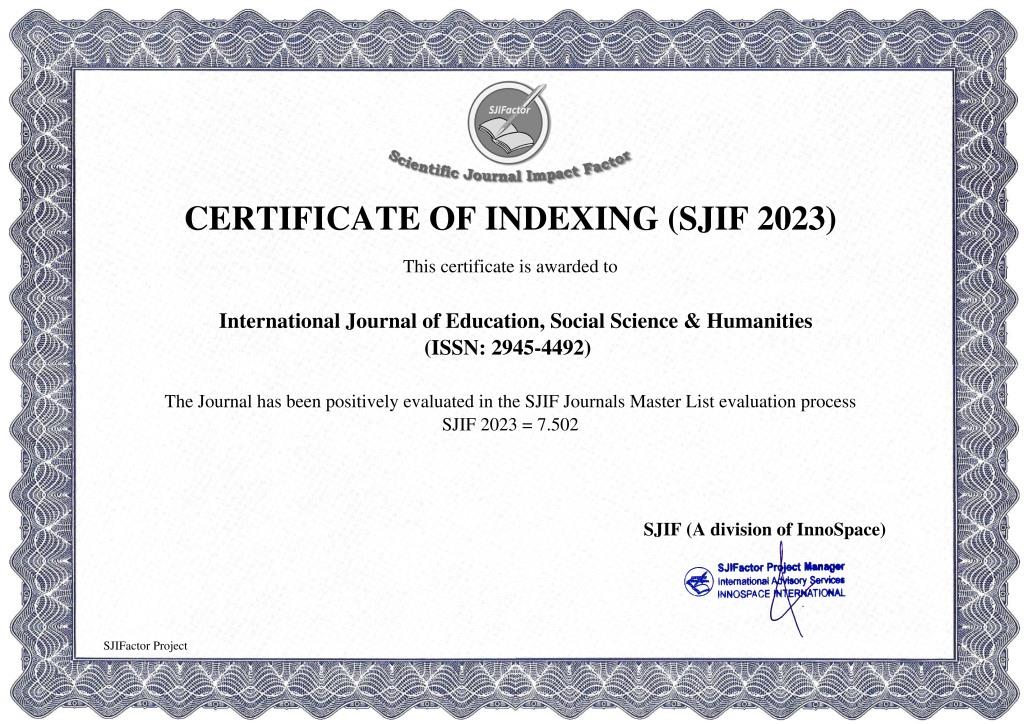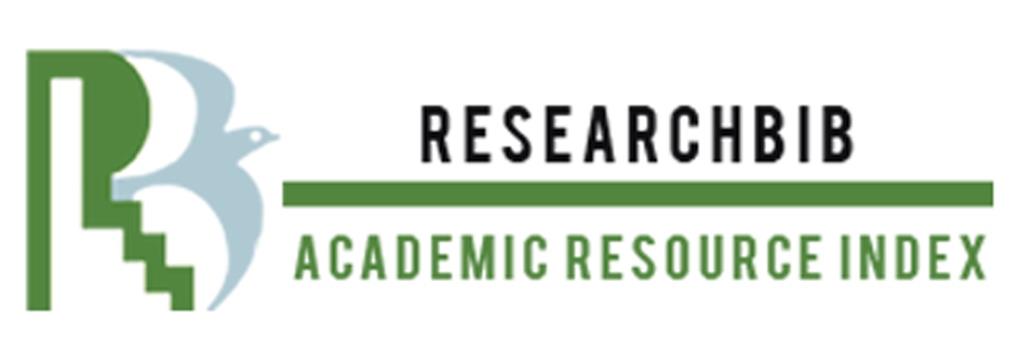MULTISENSORY METHODS IN THE PRESCHOOL SETTING
Keywords:
multisensory processing, early literacy, teaching, learning, preschool children.Abstract
Multisensory stimulation occurs when two or more sensory receptors are stimulated simultaneously. In order to effectively and accurately perceive an object, the brain combines information from the senses of sight, sound, touch, and kinaesthetics. Learning new skills can also benefit greatly from this integration. In order to improve early literacy skills in normally developing preschoolers, this chapter examines multisensory processing and its application. Although there is a lack of empirical research on the effectiveness of multisensory instruction for early literacy skill acquisition, the few studies that do exist have been carried out in ecologically valid settings and offer useful insights into the ways in which these strategies can be utilized to benefit the early literacy development of young children. In addition to the traditional visual and auditory only methods (for example, the instructor presents a printed letter and says the letter name and/or sound), these strategies may incorporate both a tactile and kinaesthetic component (for example, tracing and manipulating letters with fingers).
The focus will be on how these multisensory techniques can be used at home and in preschool. To help scaffold early literacy learning, teachers and parents should use multisensory strategies. However, in order to precisely determine the advantages of multisensory processes and instruction in early literacy learning, additional carefully controlled studies are essential.
References
Yorikulovna, S. S. (2021). Abdul Qadir Ceylani (Gilani). American Journal of Social and Humanitarian Research, 2(2), 78-81. file:///C:/Users/Admin/Desktop/340-Article%20Text-979-1154-10-20210224.pdf.
Сайидова, С. Ё. (2014). Дистанционное обучение и образование. Проблемы современной науки и образования, (6 (24)), 103-106. https://cyberleninka.ru/article/n/distantsionnoe-obuchenie-i-obrazovanie.
Yoriqulovna, S. S. (2021). Features of the Qadiriya Sect. Central Asian Journal of Literature, Philosophy and Culture, 2(5), 41-45. Retrieved from https://cajlpc.centralasianstudies.org/index.php/CAJLPC/article/view/119.
Azimova N.F; Sayidova S.Yo. "INTERACTIVE METHODS OF TEACHING RUSSIAN LANGUAGE (FOREIGN EXPERTISE VS. CLASSICAL METHODS OF TEACHING)". Journal of Contemporary Issues in Business and Government, 27, 2, 2021, 6760-5767. doi: 10.47750/cibg.2021.27.02.578. https://www.cibgp.com/article_11219.html.
Юнусова, Г.С., Сайидова, С.Ё. РОЛЬ ТРУДОВ ВЕЛИКИХ МЫСЛИТЕЛЕЙ В ВОСПИТАНИЕ НАЦИОНАЛЬНЫХ И АКСИОЛОГИЧЕСКИХ МАТРИЦ В ТЕХНИЧЕСКОМ ВУЗЕ // ORIENSS. 2022. №11. URL: https://cyberleninka.ru/article/n/rol-trudov-velikih-mysliteley-v-vospitanie-natsionalnyh-i-aksiologicheskih-matrits-v-tehnicheskom-vuze.
Azimova Nodirа Fattokhevna The factors which make listening difficult // Достижения науки и образования. 2017. №5 (18). URL: https://cyberleninka.ru/article/n/the-factors-which-make-listening-difficult.
Азимова, Н. Ф. (2017). Основные способы перевода образной фразеологии. Достижения науки и образования, (5 (18)), 80-82. https://cyberleninka.ru/article/n/osnovnye-sposoby-perevoda-obraznoy-frazeologii.
Азимова, Н. Ф. (2018). Особенности деловой коммуникации. Проблемы педагогики, (2 (34)), 24-25. https://cyberleninka.ru/article/n/osobennosti-delovoy-kommunikatsii.
Азимова, Н. Ф. (2017). Семантика словосочетаний. Достижения науки и образования, (5 (18)), 84-85. https://cyberleninka.ru/article/n/semantika-slovosochetaniy.
Азимова Назира Фаттохевна Форма и анализ словосочетания // Достижения науки и образования. 2017. №5 (18). URL: https://cyberleninka.ru/article/n/forma-i-analiz-slovosochetaniya.
Азимова Назира Фаттохевна Лексико-грамматические типы словосочетаний или морфолого-синтаксическая классификация // Достижения науки и образования. 2017. №5 (18). URL: https://cyberleninka.ru/article/n/leksiko-grammaticheskie-tipy-slovosochetaniy-ili-morfologo-sintaksicheskaya-klassifikatsiya.
Fattohevna, A. N. (2021). Nontraditional Forms of Teaching in Lessons of Russian in the Technical Higher Educational Institutions. Central Asian Journal of Literature, Philosophy and Culture, 2(5), 33-36. file:///C:/Users/Admin/Desktop/117-Article%20Text-314-1-10-20210514.pdf.
Fattohevna, A. N. (2021). Modern Pedagogical Technologies In Language Learning. American Journal of Social and Humanitarian Research, 2(2), 53-58. https://www.globalresearchnetwork.us/index.php/ajshr/article/view/336.
Азимова, Н. Ф. (2016). Темпоральная постериорная активная и постериорная стативная синтаксемы. Молодой ученый, (7), 1121-1122.
Fattokhevna, A. N. (2017). The factors which make listening difficult. Достижения науки и образования, (5 (18)), 79-80. https://cyberleninka.ru/article/n/the-factors-which-make-listening-difficult.
Khudoyberdievna, S. Z. (2022). THE MAIN FEATURES OF TRANSLATION OF PHRASEOLOGY FROM ENGLISH INTO UZBEK. Scientific Impulse, 1(3), 523-526. https://nauchniyimpuls.ru/index.php/ni/article/view/1024.
Saidova, Z. (2021). ADVANTAGES AND DISADVANTAGES OF MODULAR OBJECT-ORIENTED DYNAMIC LEARNING ENVIRONMENT (MOODLE) IN THE SYSTEM OF EDUCATION. ЦЕНТР НАУЧНЫХ ПУБЛИКАЦИЙ (buxdu. uz), 8(8). http://journal.buxdu.uz/index.php/journals_buxdu/article/view/4352.
Khudoyberdievna, S. Z. (2022). Modern Methods of Translating Phraseological Units. Eurasian Research Bulletin, 4, 153-158. https://geniusjournals.org/index.php/erb/article/view/516.
Saidova Zulfizar Khudoyberdievna. (2021). Phraseologization as Cognitive Process. International Journal of Culture and Modernity, 1, 22–26. Retrieved from https://ijcm.academicjournal.io/index.php/ijcm/article/view/4.
Khudoyberdievna, S. Z. (2021). Structural Grammar Analysis Of Phraseologism Of Mental Processes And Personal Characteristics. Web of Scientist: International Scientific Research Journal, 2(10), 137-143. https://wos.academiascience.org/index.php/wos/article/view/401.
Khudoyberdievna, S. Z. . (2021). ANALYSIS OF THE CONCEPTS OF EMOTIONS IN RUSSIAN AND ENGLISH PHRASEOLOGICAL PICTURE OF THE WORLD. Pindus Journal of Culture, Literature, and ELT, 2, 11–18. https://literature.academicjournal.io/index.php/literature/article/view/21.














